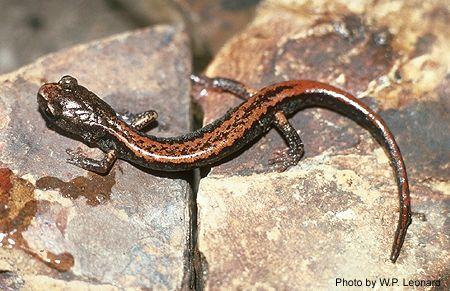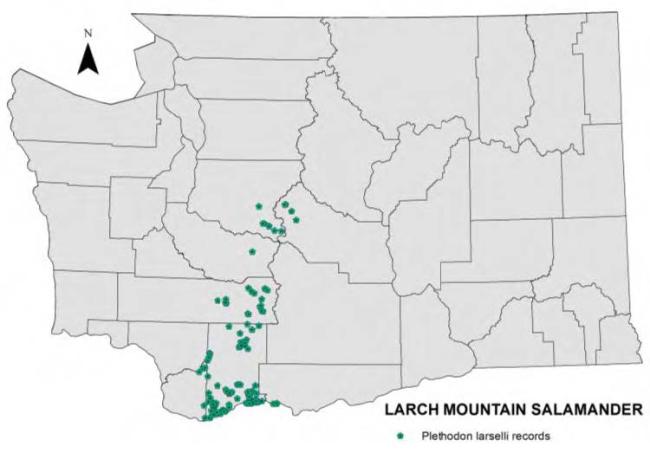Larch Mountain Salamander (Plethodon larselli)
This article was originally published by the Washington Department of Fish and Wildlife as part of its annual report Threatened and Endangered Wildlife in Washington.

State Status: Sensitive, 1993
Federal Status: Species of concern
Recovery Plans: None
State Management Plan: None
The Larch Mountain salamander (Figure 1) is a relatively rare species endemic to the Pacific Northwest. It is the smallest of the western Plethodontidae, which are lungless salamanders. They use cutaneous respiration, and for that reason, must live in moist habitats (Petranka 1998). Maintenance of subsurface microhabitats and microclimates are essential to their survival because they have a very limited period of surface activity in the spring and fall when surface moisture and temperature are suitable, and they cannot disperse long distances to find new habitat (Jones et al. 2005). The nest and courtship of Larch Mountain salamanders have not yet been described. Species of Plethodon have direct development (no tadpole) and the females guard the eggs (Wells 2007). From size-frequency distributions of Larch Mountain salamander captured from four sites in the Columbia River Gorge, Herrington and Larsen (1987 inferred that males attain sexual maturity when they were 3 to 3.5 years of age and females were sexually mature at 4 years of age. The number of eggs in a clutch ranged from 2-12 (mean=7.33, Herrington and Larsen 1987).
Larch Mountain salamanders occur primarily in Washington, with populations found in the Columbia River Gorge and in the Cascade Mountains from central Washington to northern Oregon. In Washington, they occur in Clark, Cowlitz, Skamania, Lewis, King, Pierce, Klickitat, and Kittitas counties (Figure 2). Current knowledge of the species’ range is likely incomplete and several range extensions have occurred in the past decade.
The Larch Mountain salamander is a terrestrial species dependent on late- seral forest conditions or combinations of rocky substrates, soils, and vegetation that provide suitable cool, moist microhabitat conditions (Crisafulli et al. 2008). Primary threats include timber harvest, road and trail construction, residential development, and talus mining. These activities often affect canopy closure, disturb substrates and soils, and alter microhabitats and microclimates. The species was listed as state sensitive due to its limited distribution, low numbers, fragmented habitat, and vulnerability to timber harvest and land management activities.
Nothing is known about population trends in this species. Surveys were conducted at 825 forested sites from 1996-2002, with individuals detected at only 55 (6.7%) locations (Crisafulli et al. 2008). Additional observations suggest that Larch Mountain salamanders are patchily distributed but locally abundant at a number of sites in the Columbia River Gorge and Washington Cascades (C. Crisafulli, unpubl. data, 1996-2006). In 2008, there were 145 known locations (Crisafulli et al. 2008), with 103 on federal lands and 42 on non-federal lands; most of the sites are in Washington. About 70% of currently known sites on federal lands occur in areas with special management designations, such as late seral reserves.
Wagner et al. (2005) reported that DNA analysis indicated there was substantially less differentiation among populations of Larch Mountain salamanders in Washington than in populations in Oregon. The Columbia River provides a long-term barrier indicating that populations are currently on separate evolutionary trajectories. They suggested that distinct management strategies for northern versus southern populations may be appropriate (Wagner et al. 2005).
Partners and cooperators: U.S. Forest Service.
Literature Cited
Crisafulli, C. M., D. R. Clayton, and D. H. Olson. 2008. Conservation assessment for the Larch Mountain salamander (Plethodon larselli). Version 1. USDA Forest Service Region 6, and USDI BLM, Interagency Special Status and Sensitive Species Program. 36 pp.
Herrington, R. E. and J. H. Larsen Jr. 1987. Reproductive biology of the Larch Mountain salamander (Plethodon larselli). Journal of Herpetology 21(1):48-56.
Jones, L. L. C., W. P. Leonard, and D. H. Olson, eds. 2005. Amphibians of the Pacific Northwest. Seattle Audubon Society, Seattle, Washington. 227 pp.
Petranka, J. W. 1998. Salamanders of the United States and Canada. Smithsonian Institution Press, Washington, D.C. 587 pp.
Wagner, R. S., M. P. Miller, C. M. Crisafulli, and S. M. Haig. 2005. Geographic variation, genetic structure, and conservation unit designation in the Larch Mountain salamander (Plethodon larselli). Canadian Journal of Zoology 83: 396–406.
Wells, K. D. 2007. The Ecology and Behavior of Amphibians. Chicago University Press, Chicago, Illinois. 1,148 pp.
Source: Washington Department of Fish and Wildlife. 2013. Threatened and Endangered Wildlife in Washington: 2012 Annual Report. Listing and Recovery Section, Wildlife Program, Washington Department of Fish and Wildlife, Olympia. 251 pp.



